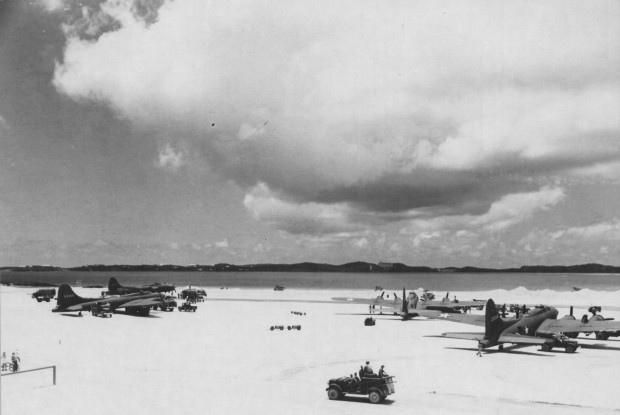WW2 B-17 Bombers Flying Through Bermuda
 Developed in the 1930s, Boeing’s B-17 Flying Fortress became one of the workhorses of the United States Army Air Force [USAAF] in World War Two — and a familiar sight at Bermuda’s newly built air field during that conflict.
Developed in the 1930s, Boeing’s B-17 Flying Fortress became one of the workhorses of the United States Army Air Force [USAAF] in World War Two — and a familiar sight at Bermuda’s newly built air field during that conflict.
Used primarily in daylight precision strategic bombing campaigns against German industrial and military targets, there were 26 B-17 bomber groups based in Britain and six groups in Italy by the time the war ended.
The heavily armed B-17 played a lesser role in the war in the Pacific.
A total of 12,700 B-17 bombers came off US factory production lines during World War Two and hundreds of the aircraft passed through Bermuda en route to the European Theatre of Operations.
The B-17 G was powered by four Wright R-1820-97 Cyclone turbo-supercharged, 1,200 horse power radial engines. It had a range of 2,000 miles and a top speed of 287 miles per hour and the bomber’s wingspan was 103 feet.
The Flying Fortress needed a crew of 10, for it was armed with 13 12.7 mm M2 Browning machine guns. It could carry a bomb load of up to 8,000 pounds.
After the war General Carl Spaatz commented that “without the B-17, we might have lost the war.”
B-17 Fortresses of the 390th Bomb Group in transit from the US to England in Bermuda, June, 1943
Following the war, some B-17 bombers made their way to the newly-created state of Israel via the black market, some were treasured by collectors in form of museums, while most of them were melted down for scrap.
The most famous of the surviving B-17 is arguably the 25-mission veteran of European Theatre “Memphis Belle”, which is now at National Museum of the United States Air Force near Dayton, Ohio, United States for restoration and display in the near future.
– Photograph courtesy of the US National Archives



D DAY was 69 years ago today.
The assault on Normandy Beaches against Nazi Germany.
Interesting article about B17′s considering today’s date.
Operation Overlord
Invasion of Normandy
The Normandy landings, codenamed Operation Neptune, were the landing operations of the Allied invasion of Normandy, in Operation Overlord, during World War II. The landings commenced on Tuesday, 6 June 1944 (D-Day), beginning at 6:30 am British Double Summer Time (GMT+2). In planning, as for most Allied operations, the term D-Day was used for the day of the actual landing, which was dependent on final approval.
The landings were conducted in two phases: an airborne assault landing of 24,000 British, American, Canadian and Free French airborne troops shortly after midnight, and an amphibious landing[4] of Allied infantry and armoured divisions on the coast of France starting at 6:30 am. Surprise was achieved thanks to inclement weather and a comprehensive deception plan implemented in the months before the landings, Operation Bodyguard, to distract German attention from the possibility of landings in Normandy. A key success was to convince Adolf Hitler that the landings would actually occur to the north at the Pas-de-Calais. There were also decoy operations taking place simultaneously with the landings under the codenames Operation Glimmer and Operation Taxable to distract the German forces from the real landing areas.[5]
Supreme Commander of the Allied Expeditionary Forces was General Dwight Eisenhower while overall command of ground forces (21st Army Group) was given to General Bernard Montgomery. The operation, planned by a team under Lieutenant-General Frederick Morgan, was the largest amphibious invasion in world history and was executed by land, sea and air elements under direct British command with over 160,000[6] soldiers landing on 6 June 1944: 73,000 Americans, 61,715 British and 21,400 Canadians.[7] 195,700[8] Allied naval and merchant navy personnel in over 5,000[6] ships were also involved. The invasion required the transport of soldiers and materiel from the United Kingdom by troop-laden aircraft and ships, the assault landings, air support, naval interdiction of the English Channel and naval fire-support. The landings took place along a 50-mile (80 km) stretch of the Normandy coast divided into five sectors: Utah, Omaha, Gold, Juno, and Sword.